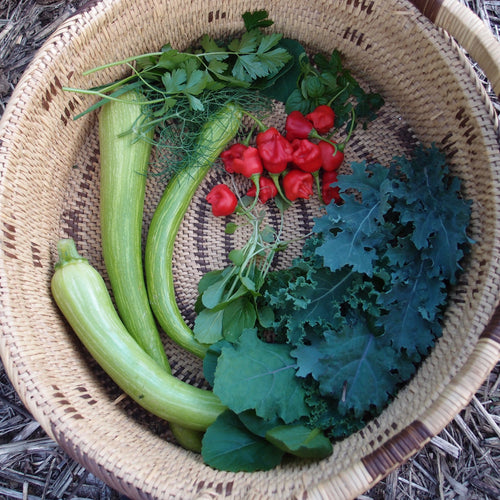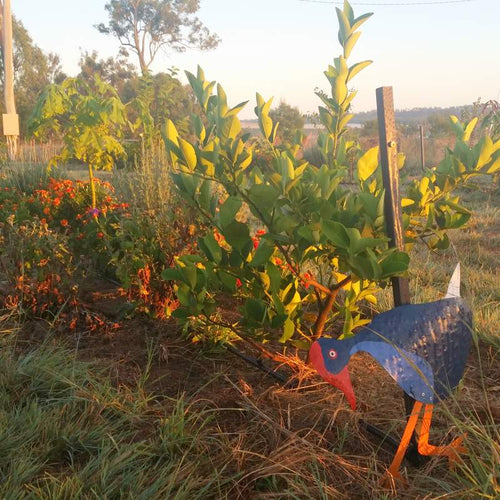Preserving the harvest
Here's a post originally from 2012. It is interesting to read this again now, as I've lately been finding that I can grow a productive and varied vege garden for most of the year, so a lot of the veges that I had preserved were not getting used up anyway. I prefer to use things up while they are fresh, but there are advantages to fermenting food and few things that I do want to use year-round, such as herbs, chilli and garlic, are easily dried.
The first year in our new garden we had so many zucchinis and beans, we were giving them away to everyone. But we hadn't got to know when we would have gluts and famines, so we didn't keep any for ourselves. Of course through winter, we had to buy veges again as I hadn't kept any. A few years on, now I'm starting to learn how to preserve some of our veges so that we will have a supply through winter. I have been drying herbs and greens, freezing zucchinis and beans, fermenting pickling cucumbers and reading about other people who use canning to preserve fruit and veges. And I've been thinking, what's the best way to preserve my harvest?
Fermenting
I think the simplest and least energy intensive method of preserving would have to be lactic fermentation. As this method lets bacteria do all the work, it doesn't require any heat or pressure, or the addition of excessive salt or sugar. The lactic acid bacteria naturally increase the acidity of the brine. The lack of temperature or pressure processing also ensures that vitamins and enzymes are retained in the veges. Apart from getting used to the taste, this would have to be the ideal method for preserving veges. I have used it so far for pickles and cabbage.
Drying
In the case of drying, food spoilage is prevented by reducing the water content of the veges. This is an energy intensive method, which I wouldn't use for high water content fruit and veges. I think its a good way to preserve herbs and greens with low water content, that don't take too long to dry. So far I've used this method to dry herbs and silverbeet (and other veges). Drying uses low temperatures(60-70 degC), so most of the enzymes and vitamins survive. One day I'd love to build a solar drier as well.
Pressure Canning
I don't have a pressure canner, so this is another method that I haven't tried. Pressure canning allows the food to be heated under pressure to higher temperatures that would be achieved at atmospheric pressure (ie water normally boils at 100degC at atmospheric pressure, but will boiler at higher temperatures in a pressure canner). This means that botulism bacteria spores are killed. This also means that salt, sugar and/or vinegar are not required to reduce the water activity, as the produce is practically sterilised, so its good for preserving sauces and veges without changing the flavours too much. It can also be used to preserve meat. I'm not sure that the excessive temperatures and pressures used for canning are really good for the nutrients in the food. I think I prefer the lower temperature methods, but I can see the benefits for preserving large amounts of fruit if you're in a fruit growing area and can get it cheaply.
How do you preserve your harvest?
The first year in our new garden we had so many zucchinis and beans, we were giving them away to everyone. But we hadn't got to know when we would have gluts and famines, so we didn't keep any for ourselves. Of course through winter, we had to buy veges again as I hadn't kept any. A few years on, now I'm starting to learn how to preserve some of our veges so that we will have a supply through winter. I have been drying herbs and greens, freezing zucchinis and beans, fermenting pickling cucumbers and reading about other people who use canning to preserve fruit and veges. And I've been thinking, what's the best way to preserve my harvest?
Fermenting
I think the simplest and least energy intensive method of preserving would have to be lactic fermentation. As this method lets bacteria do all the work, it doesn't require any heat or pressure, or the addition of excessive salt or sugar. The lactic acid bacteria naturally increase the acidity of the brine. The lack of temperature or pressure processing also ensures that vitamins and enzymes are retained in the veges. Apart from getting used to the taste, this would have to be the ideal method for preserving veges. I have used it so far for pickles and cabbage.
| Fermented pickling cucumbers |
In the case of drying, food spoilage is prevented by reducing the water content of the veges. This is an energy intensive method, which I wouldn't use for high water content fruit and veges. I think its a good way to preserve herbs and greens with low water content, that don't take too long to dry. So far I've used this method to dry herbs and silverbeet (and other veges). Drying uses low temperatures(60-70 degC), so most of the enzymes and vitamins survive. One day I'd love to build a solar drier as well.
| Drying sage |
Freezing
Preserving food by freezing also reduces the water content as the water is not available to bacteria when its solid and the low temperatures reduce bacteria growth rates. You're supposed to blanch veges before freezing to destroy enzymes that cause off-flavours. I freeze beans (sliced into 2 cm pieces), thinly sliced zucchini and squash and whole cherry tomatoes, mini capsicums and chillis. I also make soups and sauces to freeze, including pumpkin and tomato. As we have several freezers for meat anyway, its very easy for me to add a few veges to last through the winter, but this would not be ideal is freezer space was limited.
| Sliced beans for freezing |
| Cherry tomatoes ready for freezing whole (not the green ones!) |
| Roasting pumpkin in the BBQ for pumpkin soup |
Preserving
Preserving veges generally involves preventing spoilage by reducing the "water activity", this means the water available to bacteria or moulds for growth. High water activity leads to quicker spoilage. Water activity can be reduced by increasing salt, sugar or acidity, by drying the food or freezing the food. Generally preserving involves heating the produce to boiling point in a sauce containing sufficient salt, sugar or vinegar to prevent microbial growth. This includes jams, vinegar pickles and olives. I don't have any fruit to preserve (yet!), and any veges I'd rather use one of the above methods, as I don't want the heat to destroy the enzymes and vitamins in the vegetables, so I don't do any preserving so far. Pressure Canning
I don't have a pressure canner, so this is another method that I haven't tried. Pressure canning allows the food to be heated under pressure to higher temperatures that would be achieved at atmospheric pressure (ie water normally boils at 100degC at atmospheric pressure, but will boiler at higher temperatures in a pressure canner). This means that botulism bacteria spores are killed. This also means that salt, sugar and/or vinegar are not required to reduce the water activity, as the produce is practically sterilised, so its good for preserving sauces and veges without changing the flavours too much. It can also be used to preserve meat. I'm not sure that the excessive temperatures and pressures used for canning are really good for the nutrients in the food. I think I prefer the lower temperature methods, but I can see the benefits for preserving large amounts of fruit if you're in a fruit growing area and can get it cheaply.
How do you preserve your harvest?

























Leave a comment